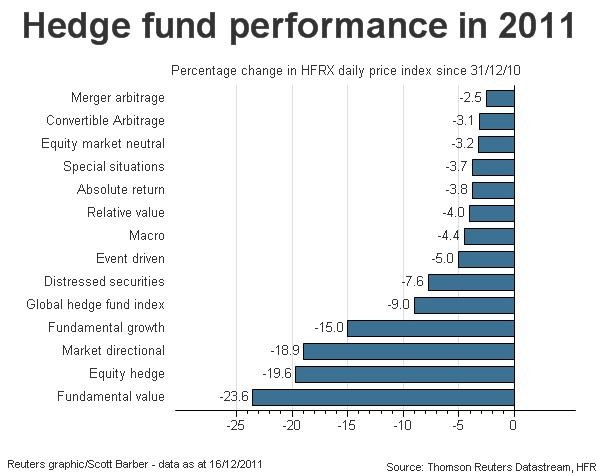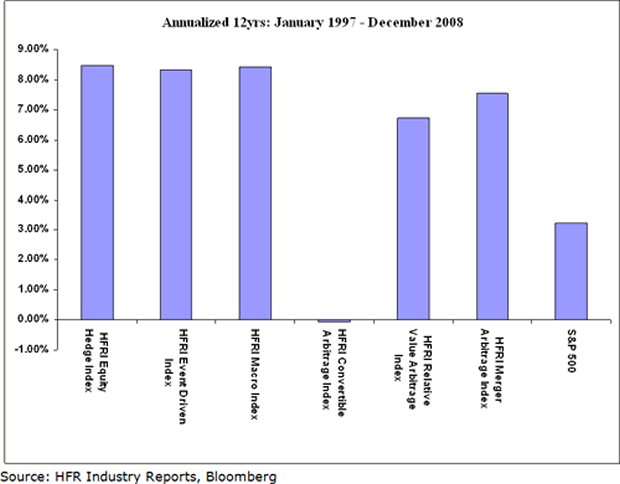Hedge Fund Strategies
Post on: 22 Август, 2015 No Comment

As previously discussed, hedge funds employ many different strategies. It is important to remember that no hedge fund strategy is standard—each portfolio manager will have his or her own unique style of investing.
Hedge fund strategies can be built from a number of different elements:
- Style: Global Macro, Directional, Event-Drive, Arbitrage
- Market: Equity, Fixed Income, Commodities, Foreign Exchange
- Instrument: Long/Short Equity, Futures, Options, Swaps
- Exposure: Directional, Market Neutral
- Sector: Healthcare, Industrials, Consumer, Energy, Real Estate, Financials, Tech, etc.
- Diversification: Multi-Manager, Multi-Strategy, Multi-Fund, Multi-Market
Hedge Fund Styles
Global Macro Style: Try to anticipate and capitalize on global macroeconomic events; this is usually considered a “top-down approach” to investing.

- Discretionary Macro: The strategy is carried out by investment managers selecting investments.
- Systematic Macro: The strategy is carried out using mathematical models and software.
- Multi-Strategy: The hedge fund uses a combination of strategies.
Directional Style: Hedge investments with exposure to the equity market.
- Long/Short Equity: Takes long equity positions while short-selling other equities or indices
- Emerging Market: Specializes in emerging markets such as China, Brazil, India, etc
- Sector Funds: Specializes in niche areas such as Healthcare, Industrials, or Consumer
- Fundamental Growth: Invests in companies with more earnings growth than the broader market
- Fundamental Value: Invests in companies that are considered undervalued
- Multi-Strategy: Uses a combination of strategies
Event-Driven Style (also called Special Situations): The fund profits from price inefficiencies caused by anticipated specific corporate events, such as bankruptcy, reorganization, divestitures, and legal situations.
Distressed Debt: Specializes in companies trading at discounts because of bankruptcy or the threat thereof.
Merger Arbitrage (also called Risk Arb): Profits from price inefficiencies relating to companies involved in announced Mergers & Acquisitions activity; a typical position might involve buying the equity of an acquisition target, and hedging the investment by shorting an appropriate amount of the equity in the acquirer.
Credit Arbitrage: Profits from relative value investments in corporate fixed income securities, such as purchasing the unsecured debt of a corporation while selling short the secured debt of the same corporation.
Activist: Takes large positions in companies and uses this ownership stake to influence the decision making of management in the companies.
Legal Catalysts: Profits from position taking with companies involved in major lawsuits.
Arbitrage Style (also called Relative Value): Profits from perceived price inefficiencies between related securities. (Note that the finance term “arbitrage” strictly means a riskless profit – seldom found in actual traded securities markets. However, the term is used to also describe investment opportunities that have a relatively high probability of profit with relatively low downside.)
- Fixed Income Arbitrage: Profits from price inefficiencies between fixed income securities
- Equity Arbitrage: Profits from price inefficiencies between equity securities (keeping a close balance between long and short positions)
- Convertible Arbitrage: Profits from price inefficiencies between convertible securities and their corresponding stocks
- Others: Statistical Arbitrage, Volatility Arbitrage, Regulatory Arbitrage
Background of Multi-Manager vs. Single P&L Model
When going through hedge fund interviews, it is important to distinguish between a multi-manager hedge fund model vs. a single P&L hedge fund model. A multi-manager hedge fund consists of multiple specialized hedge funds. Each specialized fund has its own P&L in which it is allowed to invest across different sectors and markets. The theory is founded on a premise that not all investment managers are good in all markets and not all managers are successful at all times. Spreading the investment across different Portfolio Managers allows the fund to achieve diversifications and reduce risk. A single P&L hedge fund model is a typical hedge fund; the fund has one P&L and a fixed number of Portfolio Managers.














